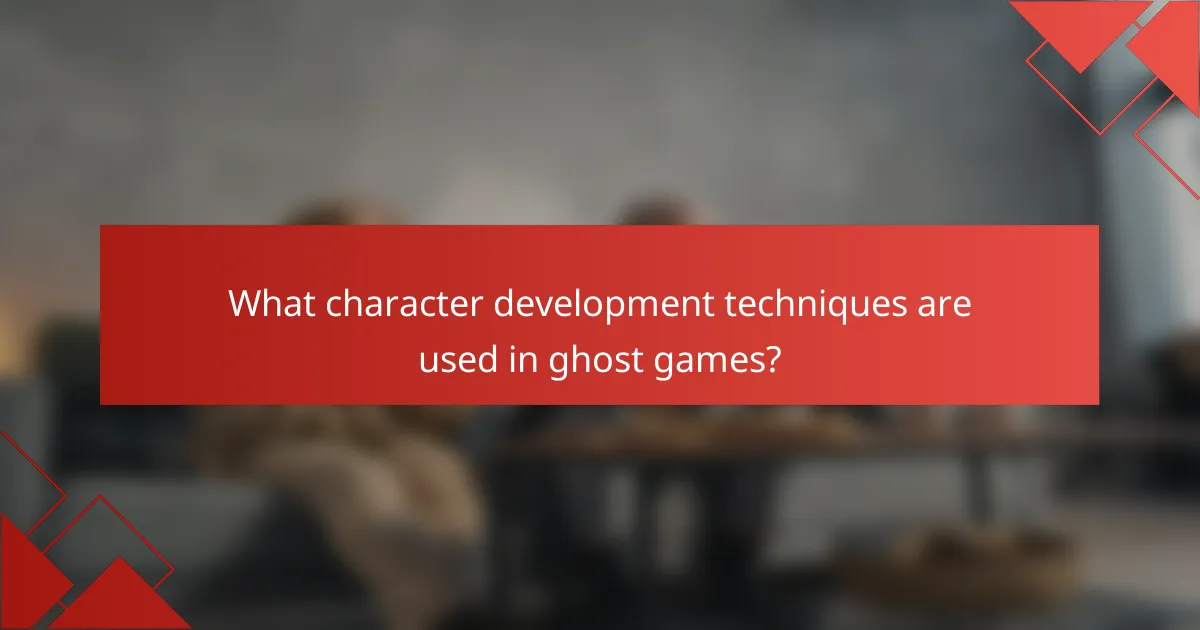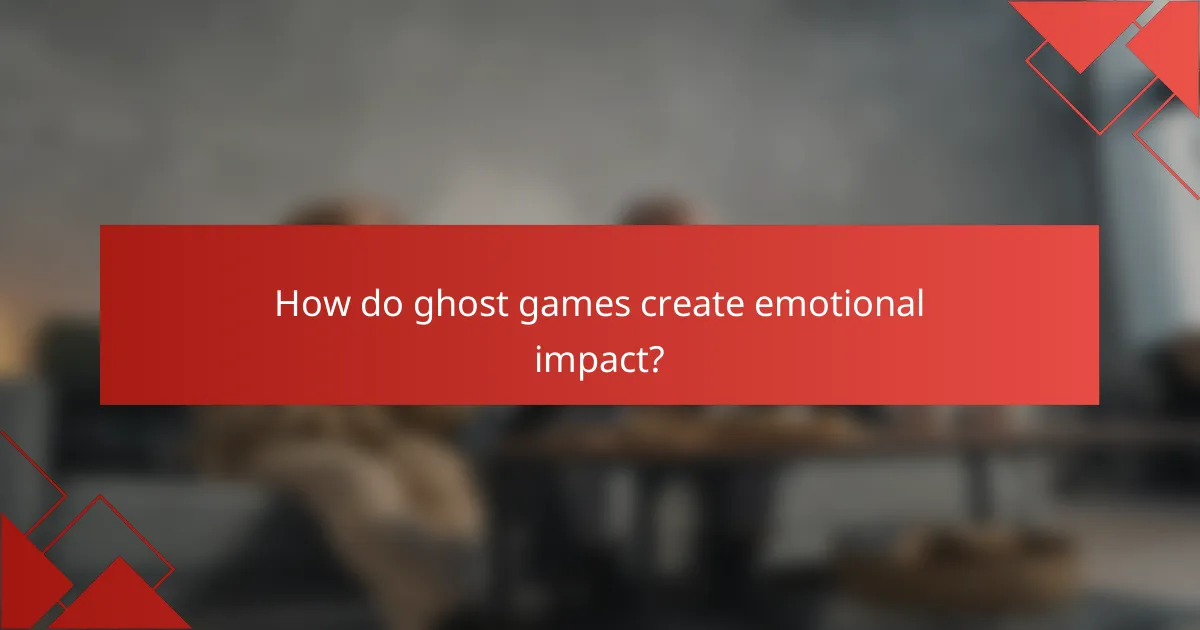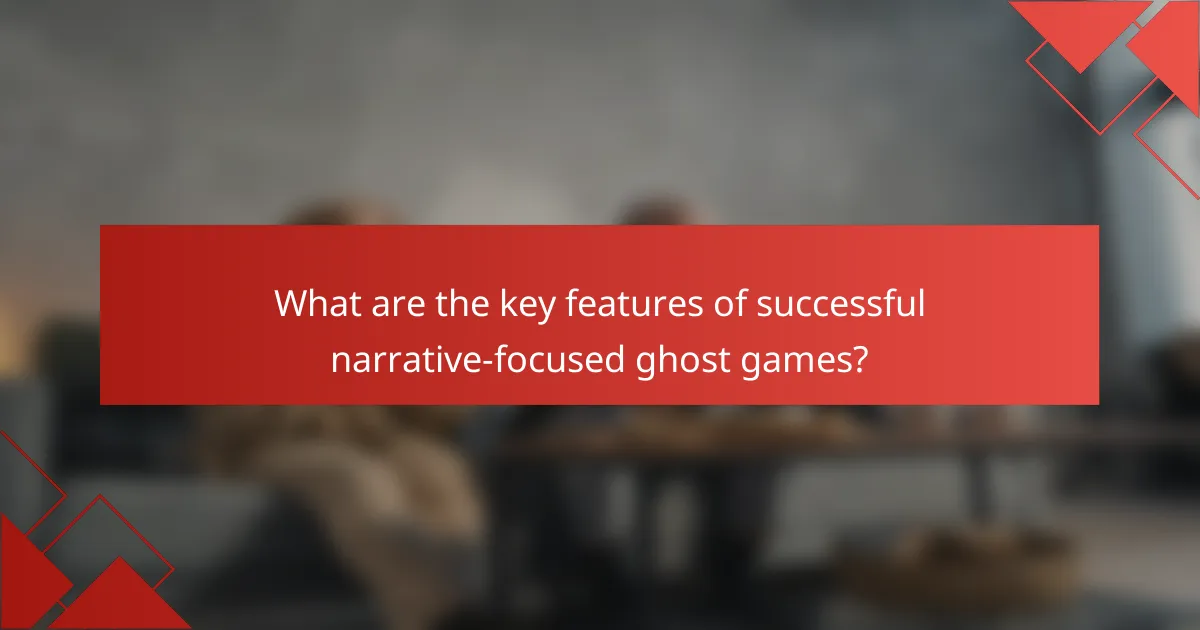Narrative-focused ghost games elevate the gaming experience by intertwining captivating stories with intricate character development and emotional resonance. By employing techniques such as complex character arcs and immersive backstories, these games foster deep connections between players and the narrative. The haunting narratives not only evoke strong emotions but also challenge players with moral dilemmas, creating a profound impact that lingers long after the game is over.

How do narrative-focused ghost games enhance story immersion?
Narrative-focused ghost games enhance story immersion by weaving compelling narratives with rich character development and emotional depth. These elements draw players into the game world, making them feel connected to the story and its characters.
Engaging storytelling techniques
Engaging storytelling techniques in ghost games often include nonlinear narratives, where players piece together the story through exploration and discovery. This approach allows for multiple interpretations and encourages players to invest emotionally in the plot.
Additionally, the use of atmospheric dialogue and voice acting can significantly enhance immersion. Well-crafted scripts that reflect the characters’ personalities and backgrounds help players form deeper connections with them.
Dynamic world-building elements
Dynamic world-building elements create a living environment that reacts to player actions, further enhancing immersion. Ghost games often feature detailed settings that reflect the history and lore of the game world, making exploration feel rewarding.
Environmental storytelling, such as visual cues and hidden items, can reveal backstories and deepen the player’s understanding of the narrative. This encourages players to engage with their surroundings and uncover the mysteries of the ghostly realm.
Player-driven narrative choices
Player-driven narrative choices empower players to shape the story based on their decisions, leading to varied outcomes and multiple endings. This interactivity fosters a sense of agency, making players feel like their choices matter within the game world.
Games that offer branching paths often include moral dilemmas, which can evoke strong emotional responses. By presenting players with tough choices, these games enhance the overall impact of the narrative and encourage replayability to explore different outcomes.

What character development techniques are used in ghost games?
Ghost games utilize various character development techniques to enhance player immersion and emotional engagement. These techniques include crafting complex character arcs, integrating backstories, and fostering emotional connections through gameplay.
Complex character arcs
Complex character arcs are essential in ghost games as they allow players to witness significant transformations in characters over time. These arcs often involve a journey of growth, conflict, and resolution, making characters relatable and memorable. For example, a character may start as a fearful individual but evolve into a courageous hero as they confront their past and the supernatural elements around them.
To create effective arcs, developers should focus on key turning points that challenge characters, prompting them to make difficult choices. This not only deepens the narrative but also keeps players invested in the outcomes of these characters.
Backstory integration
Integrating backstories into the gameplay is crucial for building depth in characters. Ghost games often reveal a character’s history through environmental storytelling, dialogue, or collectible items that players can discover. This approach helps players understand motivations and emotional stakes, enriching their experience.
For instance, a character haunted by a tragic event may encounter remnants of their past throughout the game, which can trigger flashbacks or emotional responses. This technique encourages players to empathize with the character’s struggles and enhances the overall narrative experience.
Emotional connections through gameplay
Creating emotional connections through gameplay is vital for engaging players in ghost games. This can be achieved by designing scenarios that evoke empathy, fear, or nostalgia, allowing players to form bonds with characters. Interactive choices that impact character relationships can also deepen these connections.
For example, players may face decisions that affect the fate of a character, such as choosing whether to help them confront their fears or abandon them. Such choices not only influence the storyline but also resonate emotionally, making players feel more invested in the characters’ journeys.

How do ghost games create emotional impact?
Ghost games create emotional impact by immersing players in haunting narratives that evoke strong feelings and connections to characters. Through various elements like sound design, visual storytelling, and moral dilemmas, these games engage players on a deeper emotional level.
Use of music and sound design
Music and sound design play a crucial role in establishing the atmosphere of ghost games. The right soundscapes can evoke fear, nostalgia, or sadness, enhancing the emotional experience. For instance, eerie sound effects or a haunting score can amplify tension and draw players into the story.
To maximize emotional impact, developers often use dynamic audio that changes based on player actions. This responsiveness helps create a more personalized experience, making players feel more connected to the unfolding narrative.
Visual storytelling elements
Visual storytelling elements, such as art style, color palettes, and character design, significantly contribute to the emotional depth of ghost games. Dark, muted colors can evoke feelings of despair, while vibrant visuals might highlight moments of hope or joy. The design choices made can influence how players perceive and relate to the story.
Additionally, visual cues like facial expressions and body language of characters can convey emotions effectively. Subtle animations can indicate fear or sadness, allowing players to empathize with characters’ experiences and struggles.
Player empathy and moral dilemmas
Ghost games often present players with moral dilemmas that challenge their values and provoke empathy. These choices can lead to significant emotional consequences, making players reflect on their decisions and the impact on characters’ lives. For example, deciding whether to help a ghost find peace or exploit their situation can create a profound emotional conflict.
Encouraging players to engage with these dilemmas fosters a deeper connection to the narrative. By placing players in situations where they must consider the feelings and motivations of characters, ghost games enhance emotional engagement and investment in the story.

What are the key features of successful narrative-focused ghost games?
Successful narrative-focused ghost games typically feature immersive environments, interactive storytelling mechanics, and character-driven plots. These elements work together to create a compelling experience that draws players into the game’s world and emotional landscape.
Immersive environments
Immersive environments are crucial for narrative-focused ghost games, as they establish the atmosphere and mood. Players should feel as though they are truly part of the game world, often enhanced by detailed graphics, sound design, and environmental storytelling.
To achieve this, developers can use techniques like dynamic lighting, realistic soundscapes, and intricate level design. For example, a haunted mansion might include creaking floorboards, flickering lights, and hidden passages that encourage exploration and heighten tension.
Interactive storytelling mechanics
Interactive storytelling mechanics allow players to influence the narrative through their choices, creating a personalized experience. This can involve branching dialogue options, moral dilemmas, or puzzle-solving that impacts the story’s direction and outcome.
Games should balance player agency with a coherent narrative. For instance, allowing players to choose how to confront a ghost can lead to different endings, enhancing replayability and emotional investment in the story.
Character-driven plots
Character-driven plots focus on the development of well-rounded characters whose motivations and backstories enrich the narrative. Players should connect emotionally with these characters, making their journeys more impactful.
To create compelling characters, developers can incorporate rich backstories, relatable struggles, and dynamic relationships. For example, a ghost seeking redemption may have a tragic past that players uncover through gameplay, deepening their emotional engagement.

How do narrative-focused ghost games compare to traditional horror games?
Narrative-focused ghost games prioritize storytelling and character development over the jump scares typical of traditional horror games. This approach fosters a deeper emotional connection with players, enhancing the overall experience through immersive plots and complex characters.
Focus on narrative over jump scares
Narrative-focused ghost games emphasize storytelling, allowing players to engage with the plot and environment in meaningful ways. Instead of relying on sudden frights, these games build tension through atmosphere and character interactions, creating a sense of dread that lingers.
For example, players might explore a haunted location where the backstory unfolds through environmental storytelling, dialogue, and collectibles. This method encourages players to invest time in understanding the narrative rather than merely reacting to scares.
Character depth vs. archetypal roles
In narrative-driven ghost games, characters often possess rich backstories and motivations that evolve throughout the gameplay. This depth allows players to form emotional connections, making their experiences more impactful and memorable.
In contrast, traditional horror games frequently rely on archetypal roles, such as the “final girl” or the “mad scientist,” which can lead to predictable outcomes. By developing unique characters with personal stakes, narrative-focused games invite players to empathize with their struggles and decisions.


